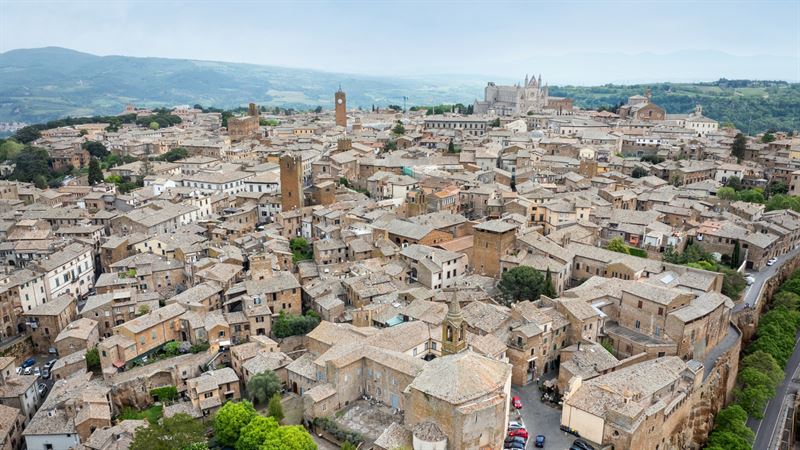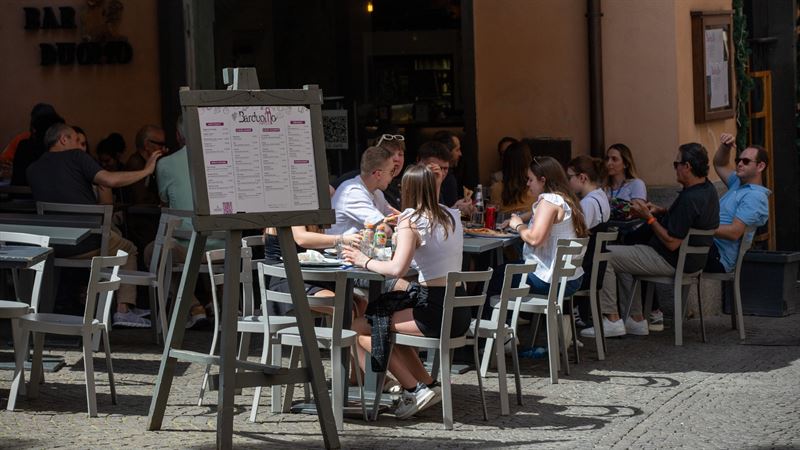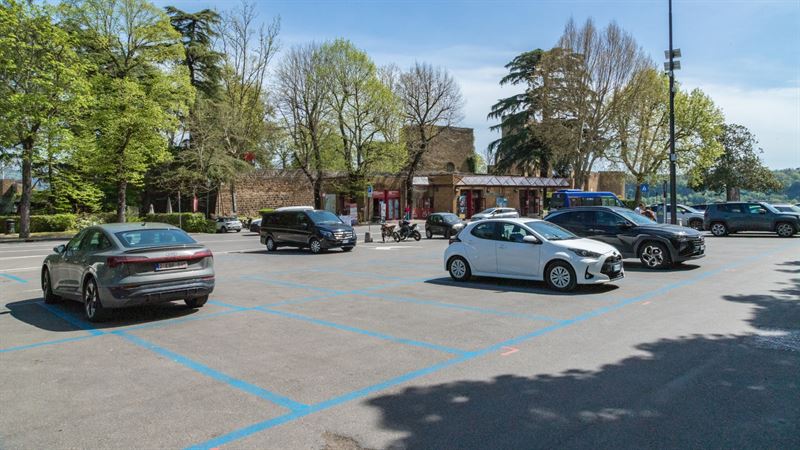Umbria, the birthplace of St Benedict and Francis of Assisi, seems bathed in a mystical glow, and Orvieto plays into the mystique. Set midway between Florence and Rome, Orvieto is Umbrian perfection, with luminous frescoes and enigmatic churches only serving to underline its lofty otherness. Looming on a sheer ledge of lava-stone, Orvieto is a brooding Etruscan presence hewn out of dark volcanic rock. In medieval times, this citadel, perched on its impregnable rock, controlled the road between Florence and Rome. Although majestically sited on top of a volcanic tufa plateau, the hill is porous and in danger of bringing the city down as it crumbles. More positively, the fertile volcanic slopes are covered in the vineyards that produce Orvieto’s famously crisp white wines. The town also scores high in the spirituality stakes, with its low-key churches counterpointed by the grandeur of the Duomo and loveliness of the undulating landscape.
Why not travel to Tuscany and see why we love it so much! Find your perfect Tuscan villa today and browse our collection near Orvieto.
Contact our Villa Specialist, who can help you find the ultimate Tuscan villa tailored to you.
Orvieto
-
-

Top Ten Things To Do
Orvieto is all about the mysterious mood, both above and below ground. Savour the slow pace of life, from medieval meanderings to wine-tasting in this Slow Food city. Orvieto also acts as a springboard to several gorgeous towns in Umbria and Lazio, all seen on day trips. Beyond the city, our Top Tip in Umbria is mystical Todi, one of the most beguiling towns in Central Italy. Our other favourite day trips are both in Lazio: Viterbo, `the Papal city,’ and Civita di Bagnoregio, Lazio’s ghost town.
-

1. Underground Orvieto – it’s a secret world
Hidden underneath Orvieto lies an intriguing underground city that winds its way beneath the main monuments. This secret city is dotted with man-made caves and a maze of Etruscan tunnels, wells, quarries, cisterns and cellars, all carved into the tufa-stone. The major noble palaces were equipped with secret escape routes from the upper city, allowing the aristocratic owners to flee if Orvieto were besieged. The tunnels took them to safety via exits that emerged some distance beyond the city walls.
The route winds through 2,500 years of city history, focusing on the Etruscan, medieval and Renaissance periods, all spread out between two different underground settlements. Carved into the cliff-face are countless tunnels and around 1,200 chambers. The underground world had numerous practical uses over the ages – including transporting water in Etruscan times, through aqueducts and water cisterns which are still functioning. In medieval times, the underground tunnels, nooks and crannies were used for pigeon-breeding, olive-pressing and even as stabling for horses. The tour begins with the remains of a medieval oil mill, with further oil presses and grindstones dating back to the 17th-century, proof of how long the olive oil industry was ensconced underground.
Don comfortable shoes and head for piazza Duomo for the start of the tour. If taken with the setting, you can come back and book your wedding in one of the Etruscan chambers or dine in a converted well.
Address: 23 Piazza del Duomo, Orvieto
Web: www.orvietounderground.it -

2. St Patrick’s Well – an engineering feat
If you can’t get enough of the underground theme, or just want a taste of it, join a visit to the so-called St Patrick’s Well, an essential city attraction. Before descending to the depths, enjoy the delightful views over Orvieto from the neighbouring city gardens off Piazza Cahen.
The well’s poetic name comes from the belief that it represented St Patrick’s Purgatory, with the promise of Paradise beyond. The well was designed by the Florentine, Antonio da Sangallo the Younger in 1527, to provide Orvieto with a reliable water supply, and took a decade to complete. This great engineering feat was commissioned by Pope Clement VII, who sought refuge here to escape Charles V’s invading forces during the Sack of Rome in 1527. Set in the lowest part of Orvieto, the site leads down 62 metres within the well shaft by means of two spiralling ramps, with the double-helix effect provided by the two flights of steps, connected by a bridge at the bottom. The cunning of this ingenious system made it possible to reach the well water with pack animals in tow but then to go back up without getting in the way of the mules coming down.
Address: St Patrick’s Well (Pozzo di San Patrizio), Piazza Cahen, Orvieto
Web: www.umbriatourism.it -

3. Medieval meanderings in Orvieto
The dark volcanic stone lends a slightly gloomy air to the city but the Medieval Quarter remains an engaging part of the town, tucked into ancient walls hung with pots of tumbling geraniums, and tiny cave-like workrooms of Orvietan artisans. The so-called `Medieval Quarter’ occupies the western part of the city and is steep, narrow and ostensibly forbidding. Serried lines of houses seem to sprout like strange appendages from the tufa-stone slopes and cling to the rocky spurs. Meander in these medieval backstreets, if only to feel the joy of seeing the tight alleys open into tiny squares or offer unexpected views of `the green heart of Umbria’ beyond the city.
More rock than town, Orvieto offers drama at every turn. The contrast between the grey basalt buildings and the tufa-stone rocks, which in the light change from mustard-tinged to golden or russet-red. The city’s wealth and power peaked in the 13th to 14th centuries and Orvieto’s medieval nature is apparent along most streets. Off Corso Cavour awaits the striking 12th-century Palazzo del Popolo, made of basalt and tufa-stone. Straight ahead are the Palazzo Comunale and the church of Sant’Andrea in Piazza della Repubblica.
Address: Orvieto Tourist Office: Piazza Duomo 24, 05018 Orvieto
Web: www.inorvieto.it -

4. Museo Claudio Faina – insights into the Etruscan world
Orvieto is an Etruscan city but the most accessible way of sensing this is to see the treasures in the city’s Etruscan museum. The Museo Etrusco Claudio Faina, set on Piazza del Duomo, opposite the cathedral, is the right spot for an overview. The museum is home to an important archaeological collection of Etruscan and Hellenistic works, mostly linked to the Orvieto area. Founded by a local count in 1864, the collections are supposedly based on a gift of vases given to the founder by Napoleon Bonaparte’s niece. (The Bonaparte family discovered the Etruscan necropolis of Vulci).
The museum highlights include Etruscan black bucchero ware, Attic vases and 4th-century pots depicting Vanth, the Etruscan winged goddess of the underworld, who has snakes wrapped around her arms. The Romans changed the Etruscan city name of Volsinii to Urbs Vetus, and hence Orvieto. Even so, the Hellenistic finds dating from the 5th-century BC attest to the fact that the city terracotta workshops still thrived during this period and copied works inspired by the Ancient Greeks. From the second floor there are lovely views over the Duomo, Orvieto Cathedral.
Address: Piazza del Duomo, 05018 Orvieto
Web: www.museofaina.it -
5. Todi – one of Umbria’s most mesmerising medieval towns
East of Orvieto is hilltop Todi, a bewitching medieval town with one of Italy’s dreamiest squares. Despite its Etruscan and Roman origins, Todi feels like a medieval fairy-tale. The town transcends its quiet charms, from labyrinthine alleyways to the set-piece main square of Piazza del Popolo. The lovely view from Piazza Garibaldi is enhanced by scents from the gardens below. Piazza del Popolo, seat of the civic and religious powers, is represented by the Gothic Palazzo dei Priori, today’s town hall, with its crenellations, battlements and mullioned windows. The grand staircase leads to a Museo-Pinacoteca but the frescoed main salon mostly overshadows the art.
On the same square stands the medieval Duomo, which rests on the site of a Roman Temple to Apollo. The three-tiered façade and bold rose window reveal a dusky interior, fine choir and stained-glass windows. The Gothic bell-tower, built 100 years later, strays from the fine Romanesque style.
A brisk walk around the hill leads to the church of San Fortunato and more views. In keeping with Umbrian tradition, it is a large vaulted church, a variant on simpler, low-pitched Tuscan “barn” churches. Given its charm, Todi has become the haunt of history of art buffs and a smugly knowing expat set.
Address: Todi Tourist Office: Piazza del Popolo 38–39, 06059 Todi
Web: www.umbriatourism.it -
6. Civita di Bagnoregio – Lazio’s ghost town
From Orvieto to Bagnoregio is only 30 minutes by car or bus but feels like a lost fantasy world. The route south borders Lake Bolsena and reveals scenery straight out of Tolkein’s Middle Earth. Civita di Bagnoregio is a semi-abandoned village often described as a ghost town. If so, it’s a ghost town coming back from the dead as it’s rightly popular with romantic visitors. Perched above a canyon and teetering atop a pinnacle is a fairy-tale medieval town that risks slipping into a ravine. This small village is perched precariously upon eroding rock and reached only by a causeway bridge.
For defensive purposes, this ancient Etruscan settlement was built on a ridge of a hill surrounded by ravines. It rose to prominence in medieval times and is still a vision of ancient carved stone archways and secret passageways. In time, landslides led to the collapse of sections of the cliff-like rock above, particularly after the 1695 earthquake, when the eastern section tumbled away. Now reached via a long pedestrian bridge over the ravine, the town revels in its dramatic setting. Visitors enter through a lofty stone passageway, cut by the Etruscans 2,500 years ago and later adorned with a Romanesque arch. Passing through the portal feels like an accomplishment, as does the return of some life to the village. Most of the houses have been restored in recent years and an advanced monitoring system regularly checks the stability of the hill.
Civita is now enjoying a second wind. The difficulty of access which once caused its almost total abandonment today attracts visitors in search of silence. Apart from lapping up the views and the sense of desolation, visitors can tuck into some home cooking in the local inns. From bruschetta slathered in olive oil to truffled pasta, the food can only taste good in such a compelling setting.
Web: https://civitadibagnoregio.cloud/ -
7. Viterbo – a taste of Tuscia in Lazio
Viterbo, the capital of Tuscia, former Etruria, makes a beguiling day out from Orvieto. Southern Umbria has much in common with Tuscia, the northern corner of Lazio. Forget the apparent strangeness of moving into another region and discover the echoes of Umbria, from the Etruscans to the impact of the Papacy. Overlooked Viterbo, directly south of Orvieto, also comes as a refreshing change after the over-popularity of too many perfect Tuscan towns.
Known as “the city of Popes,” Viterbo owes its medieval heritage to its brief period as Papal capital in the 13th century. Its medieval heyday is apparent in the showpiece squares, and in the charming San Pellegrino district east of the Cathedral, dotted with craft shops and charming back alleys.
The city centrepiece is Palazzo dei Papi, the Gothic Papal Palace, built as a residence for Popes to escape the heat, unhealthiness and clamour of Rome. In 1271, during a three-year conclave to elect a new Pope, the exasperated townspeople tore the roof off the great hall where the cardinals were conferring, and put them on bread and water. A new pope—Gregory X—was swiftly elected.
After exploring the town, make time for a refreshing dip in the local hot springs. Terme dei Papi spa complex offers a temptingly vast limestone pool fed by Viterbo's famous sulphurous waters, which pour in at 59°C (138°F).
Address: Viterbo Tourist Office. Piazza Martiri d'Ungheria, 01100 Viterbo -
8. Orvieto wine-tasting and wine tour
Orvieto is the capital of the "Città Slow" movement, meaning the epicentre of the Slow Food cities. Both Orvieto and its hinterland enjoy a centuries-old connection with the land and still preside over a flourishing food and wine scene. Celebrated Orvieto wine can be tasted along the so-called Etruscan-Roman Wine Route, which includes the entire Province of Terni. It’s worth beginning a tour with a tasting at the Enoteca Regionale dell’Umbria, the regional wine store and Umbrian wine showcase.
Download the apps to a food and wine tour: https://www.umbriatourism.it/en_US/umbriaapp
For more on wine and oil, see the Umbria tourism website (in English, French, German and Dutch): https://www.umbriatourism.it/en_US/wine-and-oil
-
9. Umbria Jazz
Music-lovers should consider visiting the region when Umbria Jazz is on. The region stages Italy’s biggest and best-known jazz festival but tries to share the spoils among different Umbrian cities. Recently, the festival has been expanding its remit, with successful versions held in different seasons. The best-known version of the festival remains the Umbria Jazz in summer, staged in Perugia, but Umbria Jazz Winter takes place in Orvieto, towards the end of December. Instead, Umbria Jazz Spring takes place in Terni, usually in late April. The Orvieto version of the festival often stages high-level American jazz but it’s always an eclectic programme. The summer jazz festival encompasses more than jazz, ranging from the music of Gilberto Gil to Pat Metheny.
Web: www.umbriajazz.com -

Eating & Drinking
Orvieto has always been farming country so visitors are spoilt for choice. Cultivating olive oil in Umbria dates back to Etruscan times, with produce around Orvieto, Assisi and Lake Trasimeno particularly prized for its intensity. Orvieto itself boasts gallina ubriaca (`drunken chicken’ drenched in wine) as a popular local dish. The city is also close enough to Norcia, the epicentre of Umbrian charcuterie, for cold cuts and salami to feature as tasty antipasti. Hearty soups are also popular in the city, especially chestnut and chickpea soup.
There is no escaping distinctive, meaty main courses. Locally-reared Umbrian meat is always on the menu, especially barbecued or roast meats, ranging from lamb to beef. As in Tuscany, Chianina cattle are a staple, with the meat prized for its succulent flavour. On the wilder side, expect wild boar, roast goose, pigeon, venison and wild boar. As in Tuscany, pork is often served as porchetta, spit-roasted and flavoured with garlic, wild fennel and local herbs. The Umbrians claim to have invented the dish, despite its popularity in Tuscany and Lazio. For dessert try the aniseed-flavoured ciambellone. a ring-shaped cake often considered an Italian version of a doughnut.
As the volcanic soil is very rich in minerals, grape vines thrive here, as they have since Etruscan times. Orvieto lends its name to the renowned Orvieto Classico, a straw-coloured white wine currently undergoing a revival. Bizarrely, Pope Gregory XVI ordered that his body be washed in Orvieto before burial. Contemporary Orvieto is made from a blend including Trebbiano and Grechetto.
-
I Sette Consoli
This elegant, pricey, fine-dining restaurant is set on a small square and has a discreet mood and a secret garden. Tuck into the turbot, venison or pigeon before moving onto the cheeseboard or, in the right season, taking the truffle menu. At the “Seven Consuls” both the service and the wine list are praiseworthy.
Address: Piazza Sant’Angelo 1A, 05018 Orvieto
Web: www.isetteconsoli.it -
Il Malandrino Bistrot
As one of the venues for Umbria Jazz, this mid-priced spot sometimes stages jazz sessions or other live music recitals inside but also has a summer terrace. The Bistrot claims to deliver soul food, if soul food means cherry tomatoes marinated in vodka, followed by pasta with truffles or a porcini mushroom sauce. Dishes are well-presented while service is friendly.
Address: Via Giuseppe Garibaldi 20, 05018 Orvieto -
Ristorante Le Grotte del Funaro
Set in the so-called “Medieval Quarter” in the west of town, this atmospheric mid-priced inn occupies a charming vaulted grotto at one with the medieval mood. In fact, it started as an Etruscan cave before becoming a rope-maker’s workshop and finally an inn. On the menu is home-made pasta, grilled meat, game and pizza.
Address: Via Ripa Serancia 41, 05018 Orvieto
Web: www.grottedelfunaro.com -
Trattoria da Carlo
Set just off the main drag, this welcoming, good-value trattoria specialises in straightforward, regional home-cooking. Typical dishes include spicy chicken and steak tartare.
Address: Vicolo del Popolo 9, 05018 Orvieto -
Trattoria La Pergola
Set not far from the cathedral, this inviting, well-run, unpretentious trattoria serves traditional Umbrian cuisine. The classic antipasti dish is a plate of Umbrian cured meats while first courses might include pappardelle pasta with wild boar or gnocchi in a Chianina beef sauce or with truffles. Desserts include panna cotta or ricotta.
Address: Via dei Magoni 9B, 05018 Orvieto
Web: www.lapergolaorvieto.com -

Shopping
Orvieto’s via Duomo and Corso Cavour are lined with elegant restaurants, boutiques and craft shops selling jewellery or Orvietan ceramics, including reproduction Etruscan ware or carved wooden sculptures. Ceramics-making is still a flourishing business in Orvieto, a tradition that dates back to Etruscan times. To sense its importance, it’s enough to do the Underground Orvieto tour. The tour reveals both ancient ceramics found in wells and more modern pottery dating back to the 18th century. At that time, certain underground chambers housed furnaces used to bake the clay. As for the art of glassmaking in the area, this dates back to medieval times when master-glassmakers made the windows for the Cathedral in Orvieto. Finish a window-shopping stroll with an ice cream in Gelateria Pasqualetti on either Piazza Duomo 14 or Corso Cavour 56.
-
Alessandro Barone Gioelli
This Roman-born goldsmith is established in Orvieto and creates jewellery made with precious or semi-precious stones. His hand-crafted creations are personalised and often one-off creations.
Address: Via Garibaldi 3/5, 05018 Orvieto
Web: www.abgioielli.net -
La Corte dei Miracoli
Expect craftmanship at this superior gift shop, which focuses on timeless terracotta pottery and ceramics, ranging from the quirky to pieces inspired by Etruscan times.
Address: Piazza de’ Ranieri 13, 05018 Orvieto -
La Torretta Ceramiche
Loredana creates charming trinkets and colourful, arty ceramics, ranging from plates, glasses and vases, mirrors and lamps.
Address: Via dei Magoni 7, 05018 Orvieto -
Tenuta Le Velette
This wine estate just outside Orvieto welcomes visitors who make an appointment. Bottles are still stored in the same cellar where the Etruscans themselves used to keep their wines. Dug from tufa stone, the cellar provides the perfect conditions for ageing wine. Wines range from Sauvignon to Sangiovese, a well as Orvieto Doc Superiore.
Address: Località Le Velette, 23, 05018 Orvieto
Web: www.tenutalevelette.com -

Parking
Street parking: Limited “pay and display” visitor street parking is indicated by blue lines, with grey ticket machines sited nearby.
Car parks: the best car park is generally Campo della Fiera – ex Foro Boario, in terms of both size and convenience. Set to the west of town, this is below the so-called `medieval district’ (“quartiere medievale’) and reached by the SS 71 road. From here, there is direct access to the city centre via lift, escalator or stairs, all of which end up close to Piazza della Repubblica. Bear in mind that while the Ripa Medici lift is open late, the escalators only run until 9pm.
Via Roma Parking, to the north, is the alternative multi-storey parking option, with further parking available on Piazza Marconi, to the south-east, directly behind Piazza Duomo (do park in designated “blue” spaces only) or in Piazza Cahen, to the north, which has a mix of free and paid parking.
Download the Orvieto city map to check the precise location of car parks:
www.orvietoviva.com/wp-content/uploads/2016/02/mappa-orvieto-orvietoviva.pdf
Web: www.orvietoviva.com/en/orvieto-parking/ -

Getting Around
Conveniently, the railway station, main taxi rank, bus station and the funicular all lie on Piazzale Matteotti in (dull) Lower Orvieto (known as Orvieto Scalo). The funicular connects Orvieto Scalo and Upper Orvieto, the lofty historic city, and stops at the top of the rock in Piazza Cahen, from where electric buses run to the cathedral if you’d rather not walk.
By road: Orvieto is about an hour’s drive from Perugia’s San Francesco airport and about 90 minutes from Rome’s Fiumicino airport or from Rome itself, and only slightly longer from Florence. If arriving via the A1 motorway, take the Orvieto exit and follow signs to the city centre, which is around 4.5 kms away. Umbria’s main tourist towns, including Perugia, Assisi and Terni, are easily accessible via the E 45 road.
By rail: Orvieto lies on the Rome-Florence-Milan rail route and is readily accessible but, once in Umbria, a hire car is still advisable for proper touring.





















